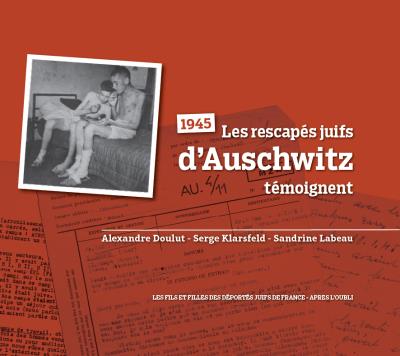
Alexandre Doulut and Sandrine Labeau
In a new French book about the deportation of Jews from France during the Holocaust, authors Alexandre Doulut, Serge Klarsfeld, and Sandrine Labeau used USC Shoah Foundation’s Visual History Archive to help identify survivors.
The book, 1945, les rescapés d'Auschwitz témoignent (which roughly translates to 1945, Auschwitz survivors testify), the authors document the testimony of one survivor from each of the 82 deportation convoys that departed from France.
The idea for the book came from the discovery of boxes at the French National Archives that contained 500 written testimonies taken by volunteers between April and July of 1945 at the Hotel Lutetia in Paris, where Auschwitz survivors were sent to be given medical treatment and recorded as a survivor.
“After the first arrivals, the French authorities realized that it was necessary to keep a written trace of what the survivors began to tell about their fate, with a view to use it in future trials against war criminals,” Doulut and Labeau said.
What French authorities didn’t know at the time, however, was that this rudimentary record was not complete.
“The ones who didn’t stay in the Hotel Lutetia in the spring of 1945 were not recorded as survivors, and if they were not French citizens, they couldn’t ask for compensation from the French authorities,” the two authors said.
A new book uses @USCShoahFdn's VHA to track French Holocaust survivors.
In order to track the French survivors who were never recorded by the government, the authors turned to the VHA. They searched several key words in the archive to isolate which survivors came from France, and then recorded all their names in an Excel File. Doulet and Labeau said that of the 385 French testimonies they found on the VHA, around 100 were not known survivors.
“Concerning the new number of survivors that we give in our book (3,389 instead of 2,500), the USC collection was a major source,” they said.
Doulut, Klarsfeld, and Labeau had previously worked together on another book. In 2010 Doulut and Labeau published a book, Les 473 déportés juifs de Lot-et-Garonne (The 473 Jews deported from Lot-et-Garonne), which was edited by Klarsfeld.
“We’ve known Serge Klarsfeld for six years: He co-edited our first book and he also gave us some of his archives so that we can work from home,” Doulut and Labeau said. “As soon as we showed him some of the testimonies we had photographed at the National Archives, he said, ‘This must be published.’”
Doulut and Labeau said their biggest takeaway from writing the book was how intense and unique the retelling of the happenings of concentration camps were just a few weeks after the Jews had been liberated.
“What struck us the most, reading these early testimonies, was the crudeness of the information given by the survivors a few weeks after their liberation,” they said. “More precisely, the abyss that stands between the one who tries to tell his sufferings and the volunteer who has to write live the incredible stories he hears.”